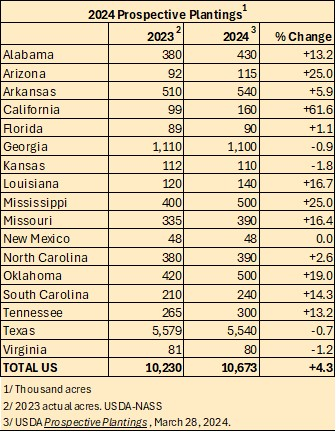USDA’s Prospective Plantings report projects that farmers intend to plant 10.67 million acres this year – 4.3% more than last year. This is less than expected. Most industry estimates were thinking acreage would be in the neighborhood of 11 million acres.
Acreage is expected to be up in 12 of 17 states. Acreage is expected to be down slightly in Texas and Georgia – the two largest states. No expected increase in Texas helped keep the total increase for the U.S. below expectations.

Prices increased only slightly despite the less-than-expected acreage number. Old crop May futures now stands (on March 31) at 91.38 cents and new crop December stands at 83.99 cents. As expected, the spread between old and new crop (May minus December) has narrowed to now +7.39 cents. This is because new crop has been stable/sideways while old crop has weakened.
It might also be that the market was not willing to commit to a larger increase prior to a long holiday weekend. We may see further follow-through action in the coming week.
The most recent export report showed 115,051 bales in sales and 376,156 bales in shipments. Sales are above previous weeks and shipments were strong. This is considered a good report and, combined with a smaller than expected increase in acreage, could be supportive of prices.

By region, the Southeast projects a decrease in corn and soybeans but increase in cotton and peanuts. The Mid-South expects increases in all. The Southwest expects a small increase in cotton but reductions in corn, grain sorghum, peanuts, and soybeans.
New crop appears to have support around 82½ cents. Prices have moved sideways between 82 and 85 cents for two months. To break above 85 and continue higher, confidence in demand must increase and uncertainties diminish. Exports must be strong. Production for 2024 could be higher than last year. So, higher demand will be needed to keep prices at current or higher levels.
Dr. Don Shurley is professor emeritus in the Department of Agricultural and Applied Economics at the University of Georgia, Tifton.
Source: cottongrower.com